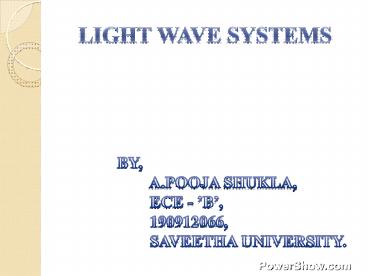light wave system PowerPoint PPT Presentation
Title: light wave system
1
LIGHT WAVE SYSTEMS
BY, A.POOJA SHUKLA, ECE - B,
190912066, SAVEETHA UNIVERSITY.
2
SYSTEM ARCHITECTURE
3
SYSTEM ARCHITECTURE
- From an architectural standpoint, it is
classified as, - POINT TO POINT LINKS
- DISTRIBUTION NETWORKS
- LOCAL AREA NETWORKS
4
POINT TO POINT LINK
- They transport information, available in the
form of a digital bit stream - The link length can vary from less than a
kilometer to 1000s of kilometer - They are used for high speed transmission
- Optical regenerators should perform,
- 1. Re-amplification
- 2. Re-shaping
- 3. Re-timing
5
- System Requirements,
- Transmission Distance
- Data Rate for a given BER
6
Other factors are,
- Attenuation
- Distance Bandwidth Product
- Cost of the connectors
- Splicing
- Then decide,
- single or multimode fiber
- step or graded index fiber
7
LOCAL AREA NETWORKS
Large number of users within a local area
8
RING TOPOLOGY
9
STAR TOPOLOGY
10
PN (PT /N)(1-d )log2N
where , d is the insertion loss of each
directional coupler. d 0.05 PT 1 Mw PN
0.1 µW N can be as large as 500
11
DISTRIBUTION NETWORK
PN PTC(1-d )(1-C)N-1
where , PT is the transmitted power C is the
fraction of power coupled out at each tap d
accounts for insertion losses, assumed to be the
same at each tap N should not exceed 60.
12
HUB TOPOLOGY
13
BUS TOPOLOGY
14
DESIGN CONSIDERATION
15
Design Considerations
- Link Power Budget
- There is enough power margin in the system to
meet the given BER - Rise Time Budget
- Each element of the link is fast enough to meet
the given bit rate
16
Receiver sensitivities Vs bit rate
17
BASIC CONSIDERATION
18
Selection of optical source,
- Emission wavelength
- Spectral line width (FWHM) and number of modes
- Output power
- Stability
- Emission pattern
- Effective radiating area
19
Selecting the detector,
- Type of detector
- APD High sensitivity but complex, high bias
voltage (40V or more) and expensive - PIN Simpler, thermally stable, low bias voltage
(5V or less) and less expensive - Responsivity (that depends on the avalanche gain
quantum efficiency) - Operating wavelength and spectral selectivity
- Speed (capacitance) and photosensitive area
- Sensitivity (depends on noise and gain)
20
Typical bit rates at different wavelengths
Wavelength LED Systems LASER Systems.
800-900 nm (Typically Multimode Fiber) 150 Mb/s.km 2500 Mb/s.km
1300 nm (Lowest dispersion) 1500 Mb/s.km 25 Gb/s.km (InGaAsP Laser)
1550 nm (Lowest Attenuation) 1200 Mb/s.km Up to 500 Gb/s.km (Best demo)
21
LOSS LIMITED LIGHT WAVE SYSTEMS
- If the signal is detected by a receiver that
requires a minimum average power at the bit rate
B, the maximum transmission distance is limited - The system requirements typically specified in
advance are the bit rate B and the - transmission distance L
- The performance criterion is specified through
the bit-error rate (BER), a typical requirement
being BER lt 10-9.
22
DISPERSION LIMITED LIGHT WAVE SYSTEM
- When the dispersion-limited transmission
distance is shorter than the loss-limited
distance of the system is said to be dispersion
limited.
BL (4Ds? )-1
- A solution to the dispersion problem is offered
by dispersion-shifted fibers for - which dispersion and loss both are minimum near
1.55 µm.
23
POWER BUDGET
- The purpose of the power budget is to ensure
that enough power will reach the receiver to
maintain reliable performance during the entire
system lifetime - The minimum average power required by the
receiver is the receiver sensitivity - It is expressed in dBm
24
RISE TIME BUDGET
- Used to ensure that the system is able to
operate properly at the intended bit rate - Even if the bandwidth of the individual system
components exceeds the bit rate, it is still
possible that the total system may not be able to
operate at - that bit rate
- It is used to allocate the bandwidth among
various components
25
- The rise time Tr of a linear system is defined
as the time during which the response increases
from 10 to 90 of its final output value when the
input is changed abruptly.
- When the input voltage across an RC circuit
changes instantaneously from 0 to V0, the output
voltage changes as, - Vout(t) V01-exp(-t/RC)
26
LONG HAUL SYSTEM
27
LONG HAUL SYSTEM
- Here we focus on the factors that limit the
performance of amplified fiber links - It depends on following factors,
- 1. Performance - limiting
factor - 2. Terrestrial light wave
systems - 3. Undersea light wave
systems
28
SOURCES OF POWER PENALTY
29
SOURCES OF POWER PENALTY
The sensitivity of the optical receiver in a
realistic lightwave system is affected by several
physical phenomena which, in combination with
fiber dispersion, degrade the SNR at the decision
circuit
30
- Among the phenomena that degrade the receiver
sensitivity are, - Modal noise
- Dispersion broadening
- Intersymbol interference
- Mode-partition noise
- Frequency chirp
- Reflection feedback.
31
FREQUENCY CHIRPING
32
THANK YOU

